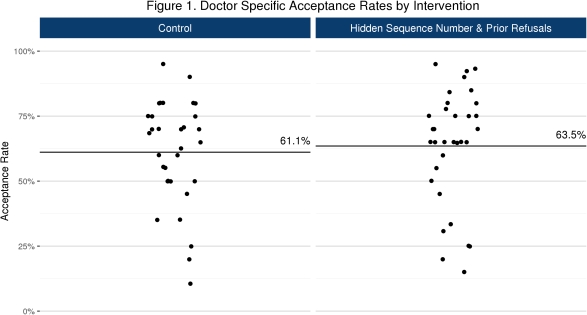DonorNet and Biases in Decision-Making: An Organ Offer Simulation Study
1UNOS, Richmond
2Duke, Durham
3CCF, Cleveland
4Wharton, Philadelphia
5UCSD, San Diego
6Wake Forest, Winston-Salem
7Yale, New Haven
8Columbia, NY.
Meeting: 2018 American Transplant Congress
Abstract number: B94
Keywords: Donors, Kidney transplantation, marginal
Session Information
Session Name: Poster Session B: Kidney Deceased Donor Allocation
Session Type: Poster Session
Date: Sunday, June 3, 2018
Session Time: 6:00pm-7:00pm
 Presentation Time: 6:00pm-7:00pm
Presentation Time: 6:00pm-7:00pm
Location: Hall 4EF
Background: Behavioral science research has revealed that the way information is presented can impact decision-making. UNOS has developed a DonorNet-like simulation tool to send hypothetical organ offers to clinicians test varying experimental conditions.
Methods: 68 MDs experienced in considering kidney offers (46 surgeons, 22 physicians) were randomized to either control or intervention (candidate “sequence number” and others' refusals hidden). From 10/30–11/10/17, each MD received the same 20 hypothetical kidney offers. 11 centers had 2+ participants. Mixed effects multivariable logistic regression modeling was employed.
Results: Consistent with a pilot study, offer acceptance rates (AR) were higher for intervention (63.5%) vs. control (61.5%), but results were not conclusive (OR=1.13, CI=0.71-1.79, p=0.60). MD-to-MD variation in ARs ranged from 11% to 95%. Remarkably, within-center MD variation ([sigma]2=0.97, p<0.0001) was 10x greater than among centers ([sigma]2=0.09, p<0.42).  Factors most associated with lower odds of acceptance included female-to-male (aOR=0.28, p<0.0001), higher donor creatinine (aOR=0.40 per mg/dL, p<0.0001), higher donor age (aOR=0.61 per 10 years, p<0.0001), candidate diabetes (aOR=0.57, p=0.002), less waiting time (aOR=0.73 per year, p=0.003), and glomerulosclerosis (aOR=0.78 per 5% increase, p=0.01). By comparison, median OR among all pairs of MDs was 0.47.
Factors most associated with lower odds of acceptance included female-to-male (aOR=0.28, p<0.0001), higher donor creatinine (aOR=0.40 per mg/dL, p<0.0001), higher donor age (aOR=0.61 per 10 years, p<0.0001), candidate diabetes (aOR=0.57, p=0.002), less waiting time (aOR=0.73 per year, p=0.003), and glomerulosclerosis (aOR=0.78 per 5% increase, p=0.01). By comparison, median OR among all pairs of MDs was 0.47.
Conclusions: In a “lab” environment, the likelihood of offer acceptance was influenced as much by the specific MD responding to the offer as by organ quality factors such as donor age and creatinine. This marked MD-to-MD variability not only hampers our ability to detect experimental effects (e.g., sequence number), but it also has implications for organ utilization. The new UNOS Labs offer simulation platform has shown promise in identifying behavioral insights and guiding system improvements.
CITATION INFORMATION: Stewart D., Lindemans J., Schold J., McGehee H., Kessler J., Sullivan C., Turner M., Mekeel K., Berg C., Stratta R., Formica R., Ratner L., Klassen D., Shepard B. DonorNet and Biases in Decision-Making: An Organ Offer Simulation Study Am J Transplant. 2017;17 (suppl 3).
To cite this abstract in AMA style:
Stewart D, Lindemans J, Schold J, McGehee H, Kessler J, Sullivan C, Turner M, Mekeel K, Berg C, Stratta R, Formica R, Ratner L, Klassen D, Shepard B. DonorNet and Biases in Decision-Making: An Organ Offer Simulation Study [abstract]. https://atcmeetingabstracts.com/abstract/donornet-and-biases-in-decision-making-an-organ-offer-simulation-study/. Accessed December 21, 2025.« Back to 2018 American Transplant Congress
